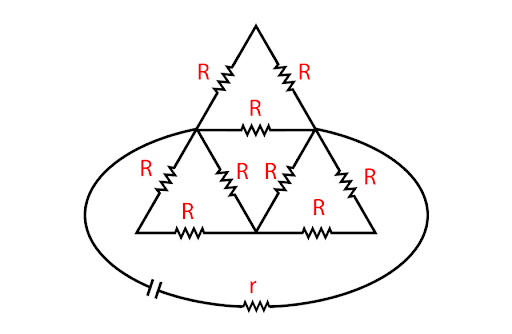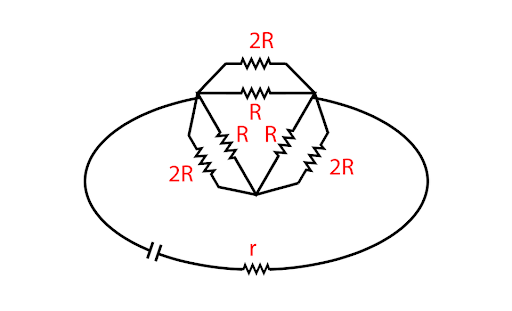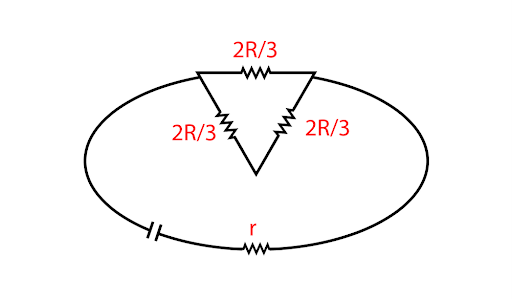
For maximum power from the battery the internal resistance of the battery

A. 10R
B. 4R/9
C. R/8
D. 10R/9
Answer
138.6k+ views
Hint:The numerical problem is from the current electricity part of physics. We can apply electric power and equivalent resistance concepts to solve the problem.
Formula used:
For maximum power, the equivalent resistance should be equal to internal resistance. That is,
Where
Equivalent resistance for a series resistance circuit:
Where
Equivalent resistance for a parallel resistance circuit:
Where
Complete step by step solution:
In the triangle part of the circuit, the three sides have two resistances in a series connection. Their equivalent resistance will be

The equivalent resistance for the three parallel combinations in the circuit will become,
$\dfrac{1}{{{R_E}}} = \dfrac{1}{R} + \dfrac{1}{{2R}} = \dfrac{3}{{2R}} \\
\Rightarrow {R_E} = \dfrac{{2R}}{3}$

The equivalent resistance for the three-series connection is,

The equivalent resistance for the final parallel connection is,
Hence, the correct option is option B.
Additional Information: Resistance blocks the flow of current. The S.I. unit of resistance is ohms. The current decreases as resistance increases. On the other hand, the current increases as the resistance decreases. A conductor's electrical resistance is affected by the following parameters: The conductor's cross-sectional area, the conductor's length, the conductor's material and the conducting material's temperature. Electrical resistance is inversely proportional to the cross-sectional area and directly proportional to the conductor's length.
Note: The rate of electrical energy transfer over an electric circuit per unit of time is measured as electric power. The S.I. unit of power is watt or joule per second. The quantity of electric power is scalar.
Formula used:
For maximum power, the equivalent resistance should be equal to internal resistance. That is,
Where
Equivalent resistance for a series resistance circuit:
Where
Equivalent resistance for a parallel resistance circuit:
Where
Complete step by step solution:
In the triangle part of the circuit, the three sides have two resistances in a series connection. Their equivalent resistance will be

The equivalent resistance for the three parallel combinations in the circuit will become,
$\dfrac{1}{{{R_E}}} = \dfrac{1}{R} + \dfrac{1}{{2R}} = \dfrac{3}{{2R}} \\
\Rightarrow {R_E} = \dfrac{{2R}}{3}$

The equivalent resistance for the three-series connection is,

The equivalent resistance for the final parallel connection is,
Hence, the correct option is option B.
Additional Information: Resistance blocks the flow of current. The S.I. unit of resistance is ohms. The current decreases as resistance increases. On the other hand, the current increases as the resistance decreases. A conductor's electrical resistance is affected by the following parameters: The conductor's cross-sectional area, the conductor's length, the conductor's material and the conducting material's temperature. Electrical resistance is inversely proportional to the cross-sectional area and directly proportional to the conductor's length.
Note: The rate of electrical energy transfer over an electric circuit per unit of time is measured as electric power. The S.I. unit of power is watt or joule per second. The quantity of electric power is scalar.
Recently Updated Pages
Young's Double Slit Experiment Step by Step Derivation

How to find Oxidation Number - Important Concepts for JEE

How Electromagnetic Waves are Formed - Important Concepts for JEE

Electrical Resistance - Important Concepts and Tips for JEE

Average Atomic Mass - Important Concepts and Tips for JEE

Chemical Equation - Important Concepts and Tips for JEE

Trending doubts
JEE Main 2025 Session 2: Application Form (Out), Exam Dates (Released), Eligibility, & More

JEE Main 2025: Derivation of Equation of Trajectory in Physics

Learn About Angle Of Deviation In Prism: JEE Main Physics 2025

Electric Field Due to Uniformly Charged Ring for JEE Main 2025 - Formula and Derivation

JEE Main 2025: Conversion of Galvanometer Into Ammeter And Voltmeter in Physics

Degree of Dissociation and Its Formula With Solved Example for JEE

Other Pages
JEE Advanced Marks vs Ranks 2025: Understanding Category-wise Qualifying Marks and Previous Year Cut-offs

Electric field due to uniformly charged sphere class 12 physics JEE_Main

Physics Average Value and RMS Value JEE Main 2025

Dual Nature of Radiation and Matter Class 12 Notes: CBSE Physics Chapter 11

Formula for number of images formed by two plane mirrors class 12 physics JEE_Main

Charging and Discharging of Capacitor




